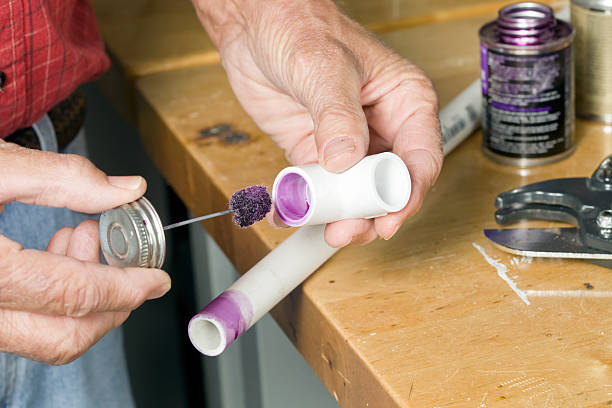Choosing the right kind of cement can be very important, especially if you are a new contractor. Besides the proper application, there are also many safety precautions that you should keep in mind. Specifically, it would help if you avoided certain things like chemical reactions and signs that your cement might be harmful.
Proper application
Whether you’re using solvent cement to connect PVC plumbing pipe or other PVC fittings, you’ll need to learn how to apply it correctly. The proper application ensures a stronger connection between pipe and fitting and will help ensure that your pipe and fittings are airtight.
First, you should use a primer to prepare the surface for the solvent cement. It prepares the area for bonding and frees surface molecules. Primers can also help prevent contamination.
After you’ve prepared the surface, apply the solvent cement with a natural bristle brush, a dauber, or a swab. Depending on the type of solvent cement, you’ll need to apply it at a specific temperature. For example, solvent cements penetrate pipe and fitting surfaces more quickly when cold but more slowly when hot. The optimal temperature for the solvent cement is usually indicated on the canister label.
After applying solvent cement to a pipe, you should wait at least 24 hours before pressure testing. It is to allow the cement to cure and set without stress. However, if you’re doing a time-sensitive project, you should use a faster setting cement.
Using solvent cement is an easy way to connect PVC plumbing pipe. This method can also help repair hairline cracks or loose drain pipes. Check the manufacturer’s instructions if you need help with how to use it.
Chemical reactions
The chemical reactions of solvent cement are essential. They allow the PVC pipe and fitting to cling together without additional materials. The process is also cost-effective. The process works by applying chemicals to the mating surfaces and then using them to bond the two pieces together chemically.
The cement solvents allow the pipe molecules and fitting to soften and swell. They then give the pipe and fitting space to move around. The speed at which the molecules dissolve will vary depending on the temperature and fineness of the cement.
The use of solvents has increased as they provide the required chemical properties. Solvents are used in many end-use applications. They are not reliable for industrial processing applications. They can become destabilized and result in dangerous by-products. The chemical reactions of solvent cement are only understood partially.
However, using different classes of solvent cement with many thermoplastic materials is possible. It is essential to read the MSDS sheets before using solvents. You should consult an expert if you still need to determine which type of solvent to use.
Signs of a bad cement
Using contact cement that could be better suited for the task is a good idea. In fact, it’s best to use it sparingly, and it’s best to keep a close eye on it at all times. Nothing is worse than a sticky cement smudge on your face or hair. The best way to avoid this is to use the best possible contact cement and apply it only on the areas you can’t see or touch.
One of the best uses for solvent cement is in waterproofing a joint. As a result, a hefty dose can weaken the bond, making it more prone to leaks than it should be. You should also be aware that solvent cement doesn’t behave well in humidity, and it is best to avoid using it during dry spells, which are notorious for causing the dreaded dry-out. If you’re the DIY type, you can make your waterproof cement. As for the process, ensure it’s the right temperature to avoid causing the dreaded dry-out.
Safety precautions
Using solvent cement to join plastic piping systems requires proper precautions. It is especially true when using the BlazeMaster solvent cement, approved for fire protection systems. Proper product use includes wearing masks, protective gloves, and long sleeves. Also, make sure that the application area is well-ventilated. Avoid working near sources of ignition or in enclosed areas. These precautions are essential for the safety of yourself and others. Check ABS Cement byipsplumbingproducts.com to learn more about this.
When using BlazeMaster solvent cement, please keep it in a cool, dark place, away from open flames. It should be used only after its shelf life. Also, avoid smoking when applying the cement. When applied, use a natural bristle brush to spread the cement. After applying the product, hold the pipe in the fitting socket for 10 – 30 seconds to allow the pieces to set. Apply a second coat if necessary. It ensures that the joints are the strongest part of the CPVC fire sprinkler system.
